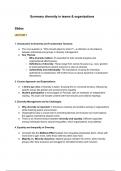Samenvatting
Summary diversity in teams and organizations - minor psychology in society
- Vak
- Instelling
Het document bespreekt diversiteit in organisaties, met nadruk op authenticiteit, groepsdynamiek, gelijkheid, en managementuitdagingen. Het behandelt inclusie, intersectionaliteit, en spanningen tussen individuele expressie en gedeelde normen binnen multiculturele teams
[Meer zien]



